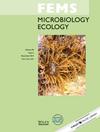Terrestrialization of sediment bacterial assemblages when temporary rivers run dry
IF 3.5
3区 生物学
Q2 MICROBIOLOGY
引用次数: 0
Abstract
Bacterial communities in river sediments are shaped by a trade-off between dispersal from upstream or nearby land and selection by the local environmental conditions. In temporary rivers (i.e., those characterized by long drying periods and subsequent rewetting) seasonal hydrological dynamics shape bacterial communities by connecting or disconnecting different river habitats. In this study, we tracked and compared the temporal and spatial changes in the composition of bacterial communities in streambed sediments and floodplain habitats across both permanent and intermittent river segments. Our findings revealed that environmental selection played a key role in assembling bacterial communities in both segments. We argue that distinct environmental features act as filters at the local scale, favoring specific bacterial taxa in isolated pools and promoting some typically terrestrial taxa in dry areas. Considering the prospective extension of drying intervals due to climate change, our results suggest an emerging trend wherein bacterial assemblages in temporary streams progressively incorporate microorganisms of terrestrial origin, well-adapted to tolerate desiccation phases. This phenomenon may constitute an integral facet of the broader adaptive dynamics of temporary river ecosystems in response to the impacts of climate change.临时河流干涸时沉积物细菌群的陆地化
河流沉积物中的细菌群落是在上游或附近陆地的传播与当地环境条件的选择之间权衡形成的。在临时性河流(即干涸期长、随后复湿的河流)中,季节性水文动态通过连接或断开不同河流生境来塑造细菌群落。在这项研究中,我们跟踪并比较了永久性河段和间歇性河段河床沉积物和河漫滩生境中细菌群落组成的时空变化。我们的研究结果表明,环境选择在两个河段细菌群落的形成过程中都起到了关键作用。我们认为,独特的环境特征在局部范围内起到了过滤器的作用,有利于孤立水池中的特定细菌类群,并促进干旱地区一些典型陆生类群的生长。考虑到气候变化可能会导致干燥期延长,我们的研究结果表明了一种新的趋势,即临时溪流中的细菌群逐渐融入了源于陆地的微生物,这些微生物能够很好地适应干燥阶段。这种现象可能是临时河流生态系统应对气候变化影响的更广泛适应动态的一个组成部分。
本文章由计算机程序翻译,如有差异,请以英文原文为准。
求助全文
约1分钟内获得全文
求助全文
来源期刊

FEMS microbiology ecology
生物-微生物学
CiteScore
7.50
自引率
2.40%
发文量
132
审稿时长
3 months
期刊介绍:
FEMS Microbiology Ecology aims to ensure efficient publication of high-quality papers that are original and provide a significant contribution to the understanding of microbial ecology. The journal contains Research Articles and MiniReviews on fundamental aspects of the ecology of microorganisms in natural soil, aquatic and atmospheric habitats, including extreme environments, and in artificial or managed environments. Research papers on pure cultures and in the areas of plant pathology and medical, food or veterinary microbiology will be published where they provide valuable generic information on microbial ecology. Papers can deal with culturable and non-culturable forms of any type of microorganism: bacteria, archaea, filamentous fungi, yeasts, protozoa, cyanobacteria, algae or viruses. In addition, the journal will publish Perspectives, Current Opinion and Controversy Articles, Commentaries and Letters to the Editor on topical issues in microbial ecology.
- Application of ecological theory to microbial ecology
- Interactions and signalling between microorganisms and with plants and animals
- Interactions between microorganisms and their physicochemical enviornment
- Microbial aspects of biogeochemical cycles and processes
- Microbial community ecology
- Phylogenetic and functional diversity of microbial communities
- Evolutionary biology of microorganisms
 求助内容:
求助内容: 应助结果提醒方式:
应助结果提醒方式:


